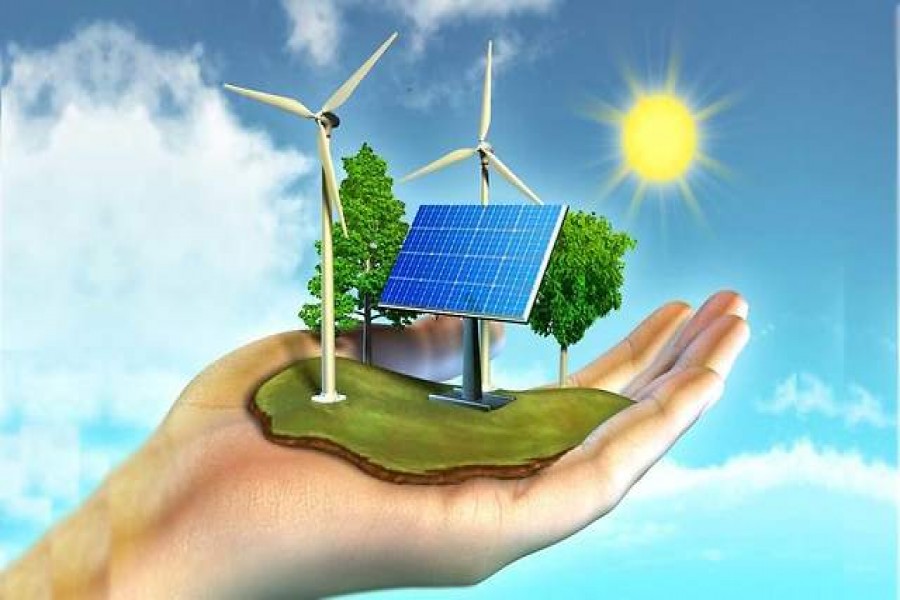In recent weeks there has been much debate over the hike in electricity price by the regulator. Bangladesh Power Development Board (BPDB) has decided to increase the bulk power tariff to reduce the tariff deficit. According to BPDB, tariff deficit exists due to increased use of furnace and diesel oil in power generation.
Alongside the debate we should also explore other issues to mitigate the demand-side pressure on energy. Bangladesh is gradually becoming dependent on external operators for its energy needs. As a country, we should focus on a well synchronous plan to meet our energy requirements while making it cost effective-- a plan that takes into account traditional fossil fuel infrastructure and renewable energy (RE) infrastructure.
Increasing the RE capacity not only addresses the energy demand but this also has other positive ancillary effects as well. Bangladesh faces imminent threat from sea-level rise due to global warming. Naturally, the country must maintain its strong stand on reducing CO2 emission through promoting and adopting clean energy initiatives.
Bangladesh has shown significant success in meeting many of the Millennium Development Goals (MDGs) given its humble resources. The key factors to achieve the goals were shared empathy to push through adversity and ingenuity to address the challenges. Bangladesh has adopted the next set of goals -- the Sustainable Development Goals (SDGs). Without a concerted effort on the RE sector we will fail to meet the SDG 7 which is to ensure access to affordable, reliable, sustainable and modern energy for all.
The renewable energy ventures might not seem cost effective. Even the highest tariff rate set for the large-scale solar plants at US$0.17 is much lower than the oil-fuelled plants. In the grand scheme of things to build systemic energy resilience, these ventures are vital investments. We must comprehend the fact that embracing such technology is a true democratising factor in ensuring access to energy and building a long-term renewable energy infrastructure. A self-sustaining infrastructure cannot be measured only by materialistic variables. The aggregate knowledge, shared experience, built-in human resources and the confidence achieved are the true assets. Recognising such potentials in diverse sectors for the future and providing government support have delivered great results for several countries.
Government-supported private sector investment for Silicon Valley initiatives in the United States saw many failures in its early days and even now. The mindset that prevailed, based on future prospect and valuation, is that even if majority of the initiatives failed, the few that would succeed would be the model for future growth and ingenuity. The renewable energy sector flourished in China, Brazil and India due to such mindset from both private sector and the government. In recent years China's renewable energy development model has surpassed that of the developed country model. In Bangladesh, Chinese energy consortiums previously worked as EPC (Engineering, Procurement and Construction) contractors. Now, these consortiums are committed to work in Bangladesh's RE sector as direct investors as well as EPC contractors. It would be beneficial for us to work in such joint ventures, so we can develop expertise through experience while building our RE infrastructure.
By the year 2020, the current government wants to ensure that 10 per cent (2000 MW) of our total energy requirement is met by RE. To reach that goal, the government has stated its support for RE projects in its Seventh Five Year Plan (2016-2020) and in the Power System Master Plan (PSMP) 2015. However, to truly asses the feasibility of such a scenario and to reach that goal, a change of mindset is required. Electricity is a public good and tariff incentives and tax breaks for entrepreneurs should be prioritised, especially for Independent Power Producer (IPP) projects in RE sector.
The country's readymade garment (RMG) sector flourished at the initial years from different economic and resource incentives. The RMG sector had and still have the advantage of availability of cheap labour while the RE sector, specifically solar power projects suffer from scarcity of land. A 10 MW solar farm requires 40 acres of land, whereas in Bangladesh per capita arable land availability is 0.12 acre. Even under such strict conditions there are almost 15-20 joint ventures by foreign investors and local entrepreneurs for utility scale solar plants (above 10MW ranging to 200 MW).
To meet Bangladesh's own benchmark of reaching 2000 MW of RE by 2020, the government should prioritise the utility (large) scale of solar plants. Based on publicly available reports, there are eighteen RE projects that are supposed to be connected to the national grid by 2020. However, due to implementation issues mostly linked to land availability and financing, most of the projects are progressing at snail's pace. According to news reports and stakeholders' statements, out of the eighteen joint ventures on solar power plant, only three are large-scale (200MW) and among those only two seem to be moving forward. Just like Padma bridge project, the ability to inaugurate the first large-scale solar power plant would be a signature achievement for the current government. The value of that achievement on public perception cannot be quantified.
Bangladesh government and its energy sector institutions should build a consensus to support RE ventures. A new mindset is required regarding the development of renewable energy by considering cost-reflective tariff and tax incentives-- as long-term systemic investment to build Bangladesh's energy resilience. For more than a decade the quick-rental power plants have delivered what they had promised - uninterrupted electricity but at high price. If our policymakers decide to go by the same principle for some of the large-scale solar plants, then we can hope to see the foundation for Bangladesh-centric design for future renewable energy infrastructure.
The writer is an Archer Fellow, Lee Kuan Yew Scholar.


